Italian Line and from 1992 Italia Line, whose official name was Italia di Navigazione S.p.A., was a passenger shipping line that operated regular transatlantic services between Italy and the United States, and Italy and South America. During the late 1960s the company turned to running cruises, and from 1981 it became a global freight operator.

SS Galileo Galilei was an ocean liner built in 1963 by Cantieri Riuniti dell' Adriatico, Monfalcone, Italy for Lloyd Triestino's Italy–Australia service. In 1979, she was converted to a cruise ship, and subsequently sailed under the names Galileo and Meridian. She sank in the Strait of Malacca in 1999 as the Sun Vista.

SS Oceanic was a cruise ship built in 1963 by Cantieri Riuniti dell' Adriatico, Monfalcone, Italy for Home Lines. Between 1985 and 2000, she sailed for Premier Cruise Line under the names Starship Oceanic and Big Red Boat I, before being sold to Pullmantur Cruises and reverting to her original name. In 2009 was sold to a new owner-operator, Peace Boat, which kept her until 2012. She was broken up in China later that year.
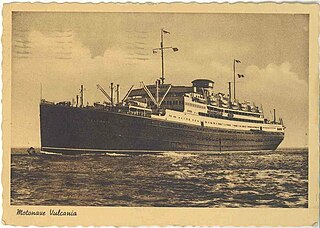
The MS Vulcania was an Italian ocean liner built by Cantiere Navale Triestino, Monfalcone, northern Italy, in 1926 for the Italian company, Cosulich Line.

SS Raffaello was an Italian ocean liner built in the early 1960s for Italian Line by the Cantieri Riuniti dell'Adriatico, Trieste. It was one of the last ships to be built primarily for liner service across the North Atlantic. Her sister ship was SS Michelangelo.

SS Giulio Cesare was a liner of the Navigazione Generale Italiana, which was later operated by the Italian Line. The ship was used to transport first class, second class, and tourist-class passengers.

SS Conte Biancamano was an Italian ocean liner launched in 1925. The name was chosen in honor of Humbert I Biancamano, founder of the Savoy dynasty. She was built in the Scottish shipyard William Beardmore & Co. in Dalmuir, near Glasgow. She was built for the Genovese shipping company Lloyd Sabaudo, operator of Conte Rosso and Conte Verde. The engine, equipped with two steam turbines double reduction unit and two propellers, allowed her to reach a speed of 20 knots, and vented in two funnels. She housed 180 passengers in first class, 220 in second class, 390 in economic class and 2,660 in third class.

SS Independence was an American built passenger liner, which entered service in February 1951 for American Export Lines. Originally, she plied a New York-Mediterranean route, specializing in a high-end clientele, sailing one way while her sister ship, SS Constitution, plied the route the opposite. Starting in 1980 she sailed as a cruise ship. She was shortly joined by her similarly graceful counter sterned sibling, the pair sharing the Hawaiian islands together for the better part of two decades until their retirements.

RMS Sylvania was an ocean liner built in 1957 by John Brown & Company, in Glasgow, Scotland for Cunard. She was the last Cunard vessel built specifically for transatlantic crossings. The ship was later heavily rebuilt as a cruise ship, and sailed under the names SS Fairwind, SS Sitmar Fairwind, SS Dawn Princess and SS Albatros before being scrapped in 2004. She was renamed SS Genoa for her last voyage.

SS Bretagne was an ocean liner launched on 20 July 1951 out of Saint-Nazaire; the second of two ships built for the Société Générale de Transport Maritimes (SGTM) which operated passenger lines out of Marseilles. Her sister ship Provence was launched a year earlier at Newcastle. Bretagne was constructed with three boilers and Provence with only two, making Provence less capable of increasing speed to counteract possible delays.

MS Stockholm was the name of two near-identical ocean liners built by Cantieri Riuniti dell' Adriatico, Monfalcone, Italy between 1936 and 1941 for the Swedish American Line. Neither of the ships entered service for the company that had ordered them—the first ship was entirely destroyed by fire during construction in 1938, while the second was completed in 1941 but immediately sold to the Italian government as a troopship. The second ship served for three years in the Regia Marina and Kriegsmarine under the name MS Sabaudia, until sunk by British bombers outside Trieste in 1944. It is unknown if she was ever actually used as a troopship.
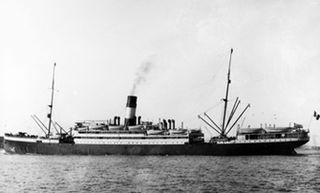
SS Taormina was a transatlantic ocean liner that was launched in Scotland in 1907 for an Italian shipping line. She was owned successively by Italia Società di Navigazione a Vapore, Lloyd Italiano and Navigazione Generale Italiana (NGI). Taormina was briefly chartered as a troop ship for the US Armed Forces in 1918. She was scrapped in 1929.
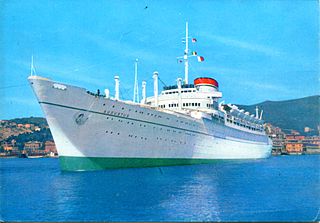
MS Augustus was a 27,090 GRT, luxury ocean liner built in 1950 for Italian Line. She was the sister ship to MS Giulio Cesare that was launched in the same year. These two ships were built to the same design, with similar specifications. After the Augustus was sold to Hong Kong, she sailed under five names. The ship was later sold to Manila Hotel and renamed MS Philippines, functioning as a static hotel. As reported by both Maritimematters, and maritime, the MS Philippines was sold for scrap in September 2011. As of December 2011, she was beached in Alang for scrapping.
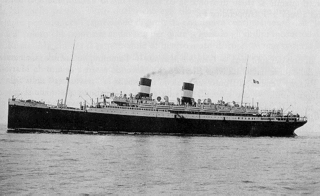
SS Roma was an ocean liner built for the Italian shipping company Navigazione Generale Italiana of Genoa by Ansaldo shipyard in Sestri Ponente. She was the sister ship to MS Augustus. The ship was later transferred to the new Italian Line after the merger of Navigazione Generale Italiana. When Second World War broke out, she was acquired by the Navy for Conversion to aircraft carrier name Aquila. She was taken over by the National Republican Navy of the Italian Social Republic and German occupation forces in 1943, but was partially sunk in 1945 by a commando attack of Mariassalto, an Italian royalist assault unit of the Co-Belligerent Navy of the Kingdom of Italy, made up by members of the former Decima Flottiglia MAS. Roma was raised and scrapped by 1952.
Sparviero was an Italian aircraft carrier designed and built during World War II of the Regia Marina. She was originally the ocean liner MS Augustus built in 1926 for Navigazione Generale Italiana, but was transferred to the new Italian Line after the merger of Navigazione Generale Italiana with the Lloyd Sabaudo and the Cosulich Line. The conversion was started in 1942 originally under the name Falco but was never completed, and the ship was never delivered to the Regia Marina. She began to be scrapped in 1947, a process completed by 1951.

SS Duilio was the first Italian super ocean liner and one of the largest Italian merchant ships until 1925. She measured 24,281 gross register tons and was the sister of the SS Giulio Cesare, which was launched in 1921. She was constructed for the Italian shipping company “Navigazione Generale Italiana” based in Genoa and constructed by Ansaldo Shipyard owned by Sestri Ponente. She was sunk on 10 July 1944.

Lavia was a cruise ship that caught fire and sank in Hong Kong Harbour in 1989. She was built for Cunard White Star Line in 1947 as the cargo liner Media. In 1961 she was sold to Italy, rebuilt as an ocean liner and renamed Flavia. In 1969, she was refitted as a cruise ship and renamed Flavian. In 1982 she was sold to Panama and renamed Lavia. She was undergoing a refit when the fire occurred. The damage to her was so great that she was scrapped.
SS Verona was a transatlantic ocean liner that was built in Ireland in 1908 for an Italian shipping line. She was a troop ship in the Italo-Turkish War of 1911–12 and in the First World War in 1917–18. In 1918 a German submarine sank her in the Mediterranean with great loss of life.
SS Melita was one of a pair of transatlantic steam ocean liners that were built in the United Kingdom, launched in 1917 and operated by Canadian Pacific until 1935. Her sister ship was Minnedosa.
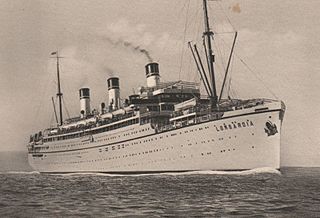
SS Lombardia was one of a pair of transatlantic steam ocean liners that were launched in 1914 in Germany for the Hamburg America Line (HAPAG), sold to a Dutch shipping line in 1916, and seized by the United States as World War I reparations in 1922. United American Lines (UAL) operated her until 1926, when HAPAG bought her back.
















